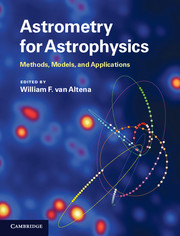Book contents
- Frontmatter
- Contents
- List of contributors
- List of acronyms
- Preface
- Part I Astrometry in the twenty-first century
- Part II Foundations of astrometry and celestial mechanics
- 4 Vectors in astrometry: an introduction
- 5 Relativistic foundations of astrometry and celestial mechanics
- 6 Celestial mechanics of the N-body problem
- 7 Celestial coordinate systems and positions
- 8 Fundamental algorithms for celestial coordinate systems and positions
- Part III Observing through the atmosphere
- Part IV From detected photons to the celestial sphere
- Part V Applications of astrometry to topics in astrophysics
- Index
- References
8 - Fundamental algorithms for celestial coordinate systems and positions
from Part II - Foundations of astrometry and celestial mechanics
Published online by Cambridge University Press: 05 December 2012
- Frontmatter
- Contents
- List of contributors
- List of acronyms
- Preface
- Part I Astrometry in the twenty-first century
- Part II Foundations of astrometry and celestial mechanics
- 4 Vectors in astrometry: an introduction
- 5 Relativistic foundations of astrometry and celestial mechanics
- 6 Celestial mechanics of the N-body problem
- 7 Celestial coordinate systems and positions
- 8 Fundamental algorithms for celestial coordinate systems and positions
- Part III Observing through the atmosphere
- Part IV From detected photons to the celestial sphere
- Part V Applications of astrometry to topics in astrophysics
- Index
- References
Summary
Introduction
This chapter offers practical advice to anyone developing, or supporting, astrometric computer applications related to celestial coordinate systems and positions. It identifies sources of ready-made software, useful in its own right or as benchmarks, and references to the underlying algorithms. This will be found useful in realizing many of the transformations detailed in Chapter 7, in which the theoretical bases and definitions of the transformations are provided. We shall limit ourselves to the sequence of transformations for ground-based astrometry of stars that links catalog coordinates with the direction of the incoming light as seen by the terrestrial observer. The catalog information with which the sequence begins typically comprises ICRS (International Celestial Reference System) right ascension and declination [α, δ], and space motion in the form of proper motions in α and δ plus parallax and radial velocity. The final observed coordinates [A, E] stand for azimuth and altitude, the latter informally called elevation. The sequence of transformations in this chapter are meant to aid the user who needs to take information in an astrometric catalog and predict the observed coordinates, in contrast to the situation in Chapter 19, where the observer wishes to transform in the opposite sense, i.e. from the observed coordinates to the final catalog positions.
- Type
- Chapter
- Information
- Astrometry for AstrophysicsMethods, Models, and Applications, pp. 112 - 118Publisher: Cambridge University PressPrint publication year: 2012



